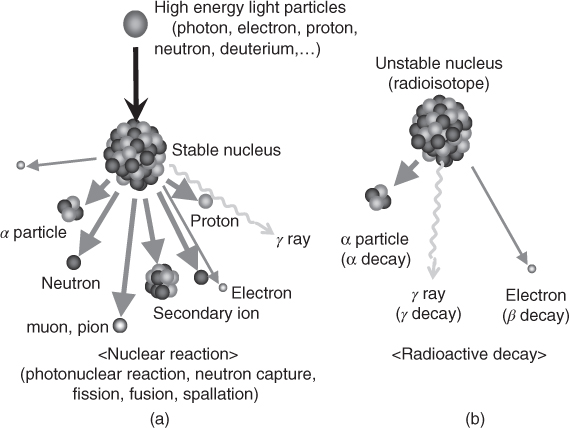Chapter 2Terrestrial Radiation Fields
2.1 General Sources of Radiation
Figure 2.1 depicts two simplified mechanisms by which photons and/or secondary particles are produced.

Figure 2.1 Sources of terrestrial radiation: (a) nuclear reactions (photonuclear reaction, neutron capture, fission, fusion and spallation) and (b) radioactive decay
When a high-energy particle penetrates into a nucleus, various nuclear reactions take place with to the end result of decomposing the nucleus into fragments as shown in Figure 2.1a. The nuclear reactions are likely to be: neutron capture [1], fission [2], fusion [3] and spallation reaction [4]. As a result of the reactions, energetic photons, electrons, neutrons, protons, muons, pions and heavier particles are released with a residual nucleus. Even high-energy photons and electrons can produce neutrons, protons, deuteriums, tritiums and alpha particles through photonuclear reaction [5]. When these particles are charged particles, they are known as secondary ions. Photons (gamma rays), electrons (beta-rays) and helium ions (alpha-rays) are emitted through radioactive decay of unstable radioisotopes as shown in Figure 2.1b.
2.2 Backgrounds for Selection of Terrestrial High-Energy Particles
As shown in Chapter 1, most terrestrial high-energy particles are studied in this book because those particles listed in Table 2.1 have a charge or at ...
Get Terrestrial Radiation Effects in ULSI Devices and Electronic Systems now with the O’Reilly learning platform.
O’Reilly members experience books, live events, courses curated by job role, and more from O’Reilly and nearly 200 top publishers.

